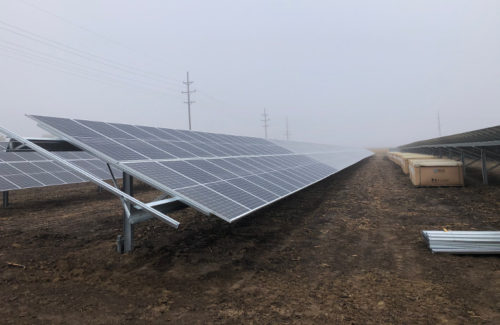The solar market in Illinois imitates many in the Midwest — very middle of the pack. Ranked 28th in the nation for installed solar capacity, Illinois does have well intentioned solar legislation but the follow-through has been less than exemplary.
In 2016, Republican Gov. Bruce Rauner signed the Future Energy Jobs Act (FEJA) which propped-up Illinois’ renewable portfolio standard (RPS) of 25% by 2025 by providing over $200 million in annual funding for renewable resources. Solar project developers seeking renewable energy credits (RECs) now apply for funding through the Adjustable Block Program (ABP). The ABP offers a set price for RECs in three categories — small DG, large DG and community solar. The goal for the ABP was to have enough contracts to result in 1 million credits being delivered annually by 2021, which would spur 666 MW of new PV generation in the state.
The problem? Illinois underestimated the interest companies would have in building solar projects in the state. Illinois went from around 12.9 MW installed annually in 2017 to 106 MW in 2019. Over 800 community solar projects were waitlisted as early as 2018, with the large DG project category of the ABP reaching its capacity in early 2020 — there is no more funding or RECs to dole out. FEJA was successful in stimulating a stagnant solar market, but now its popularity is threatening to bring a burgeoning industry to a stand-still.
As soon as projects began stalling out, a group of trade organizations, local solar installers and policymakers formed the Path to 100 Coalition to bring awareness to the threats against the renewable energy industry.
“If I had to pinpoint the most immediate concern for the industry, it would be addressing the funding cliff in Illinois. It’s something that we have been calling to the attention of stakeholders in Illinois for some time,” said Nakhia Morrissette, central region director for SEIA and spokesperson for the Path to 100 Coalition. “Our industry is losing quite a bit of jobs. Illinois companies are getting to the point where they have to make a decision about whether the market here is sustainable.”
SunVest is one of those companies. Although headquartered in neighboring Wisconsin, the commercial solar developer took advantage of FEJA opening the Illinois DG and community solar markets and now has a team in the state. Tim Polz, senior VP of development, said that SunVest developed and constructed nearly 10 MW of large DG projects in Illinois last year and has 105 community solar projects developed and submitted to the ABP. Only 10 of those projects received REC contracts.
“Without credit contracts, it would be difficult to realize the same uptake from customers because the cost of doing so to the end user would be much higher,” Polz said. “We are constructing many of the projects that were awarded REC contracts through the initial procurement under the Adjustable Block Program. Looking forward to 2021, we have shifted resources from Illinois to other markets simply because we don’t know whether or not there will be opportunities for us to build out solar projects here in Illinois.”
There have been some moves to fix the situation. With Path to 100 Coalition input, the Path to 100 Act was introduced in both the House and Senate in 2019 to expand the state’s RPS to 40% by 2030 and ensure sufficient funds to reach the new goal. Although not yet passed, the goals of the Path to 100 Act already have the support of Democratic Gov. JB Pritzker, who had campaigned on 100% clean energy.
“It’s a pretty big deal that Gov. Pritzker is taking the lead on what energy legislation would look like,” said Peter Gray, spokesperson for the Illinois Solar Energy Association and the Path to 100 Coalition. “That kind of leadership that is looking to be fair across industries and benefit solar companies small and large — that’s something that’s going to benefit Illinois and has been lacking in previous administrations.”
To give a push to legislators, Gov. Pritzker released in Aug. 2020 eight principles to guide energy reform. Principle 3 specifically proposed to make Illinois a renewable energy leader by:
- Working toward 100% clean energy by 2050
- Creating new net-metering credits
- Removing barriers to solar development
- Creating a community solar structure that values efficiency instead of low-cost land
- Improving the permitting process
- Improving interconnection methodology
- Facilitating energy storage deployment
The governor’s office has convened working groups to help shape legislation for passage during this fall’s veto session. Fixing those funding gaps that are currently preventing projects from being built and potentially threatening renewable energy jobs is of top concern.
The Path to 100 Coalition is taking its cues from the governor’s office and is currently helping with the working groups. But everything is on an accelerated timetable — funding is already running dry and the Illinois General Assembly Veto Session lasts just two weeks in November and December. If nothing is passed, the Illinois solar market in 2021 could be a ghost town.
“Illinois in 2007 [established] a 25% by 2025 RPS. We’re now getting the functional pieces in place to really start to reach that goal. We’re seeing that we can do it: We can build renewables fast that customers want,” Morrissette said. “Those goals are achievable, but putting the mechanisms in place that really work for businesses to build and customers to buy is critical.”
Companies like SunVest must now just wait and see what happens.
“We have been in contact with various legislators over the last year to let them know that this cliff is coming,” Polz said. “I don’t know what [Illinois] could have done better other than to better anticipate the interest in the program and provide for a mechanism to continue funding and continue available capacity from the start. That’s what we’re trying to do now, and hopefully we’ll be able to provide a solution before the cliff arrives.”
This story is part of Solar Power World’s annual Regional Solar Policy Report. Find out more in our digital edition of the magazine.








I was supposed to be getting about $9000 back on my purchase of a 6kw system. Now I’m looking at nothing. Of course my installer says nothing was ever guaranteed. I keep seeing all these articles about how it’s affecting installers but what about the Illinois residents who put up the cash to do solar only to find out the price of the project was WAY higher than quoted AFTER the project was completed?
I believe sooner or later, many established IOU electric utilities will be asked to “share the pain” and finally “told” to share the pain by legislation or regulation. “Regulated monopolies” are allowed to file electricity rate case increases if the amount of electricity sold curtails, “lost revenues” from efficiency or DG in a region. These utilities are also allowed electricity rate case increases for “stranded assets” when old fueled generation is decommissioned. It will get to the point where, the individual ratepayer will install their own self consumption system, large solar PV array and smart ESS. When enough folks pay it forward to buy their own generation, energy storage systems, it may be too late for the utility to survive.
California has made its energy mandates too. The way the electric utilities have handled this is tiered electricity rate structures, TOU rate spiking just after the solar PV generation drops off for the day and demand charges to fill in the “cracks”. When there are times of the day when you are paying $0.20/kWh up to $0.48/kWh for electricity, it makes sense to have your own self consumption and energy storage system in your home. The solar PV R&D is pushing the limit of efficiencies right now. The R&D on tandem or trinary solar PV cells will begin a new push for solar harvest efficiency. When one gets to the 40% efficient solar PV panel, it will allow those with 400 to 600 square feet of space on their roofs to put in nominal solar PV generation of from 13kWp to 20.5kWp on their roofs.
Does NO-BRAINER apply here? What couldn’t be better for the local economy, the environment, and under-served? All legislators need to support this or be very specific as to why they are not supporting it.